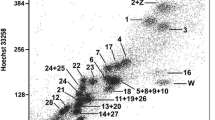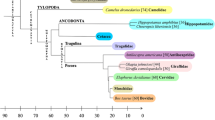Abstract
Domestic cats and dogs are important companion animals and model animals in biomedical research. The cat has a highly conserved karyotype, closely resembling the ancestral karyotype of mammals, while the dog has one of the most extensively rearranged mammalian karyotypes investigated so far. We have constructed the first detailed comparative chromosome map of the domestic dog and cat by reciprocal chromosome painting. Dog paints specific for the 38 autosomes and the X chromosomes delineated 68 conserved chromosomal segments in the cat, while reverse painting of cat probes onto red fox and dog chromosomes revealed 65 conserved segments. Most conserved segments on cat chromosomes also show a high degree of conservation in G-banding patterns compared with their canine counterparts. At least 47 chromosomal fissions (breaks), 25 fusions and one inversion are needed to convert the cat karyotype to that of the dog, confirming that extensive chromosome rearrangements differentiate the karyotypes of the cat and dog. Comparative analysis of the distribution patterns of conserved segments defined by dog paints on cat and human chromosomes has refined the human/cat comparative genome map and, most importantly, has revealed 15 cryptic inversions in seven large chromosomal regions of conserved synteny between humans and cats.
Similar content being viewed by others
References
Breen M, Thomas R, Binns MM, Carter NP, Langford CF (1999) Reciprocal chromosome painting revealed detailed regions of conserved synteny between the karyotypes of the domestic dog (Canis familiaris) and human. Genomics 61: 145–155.
Dutrillaux B, Couturier (1983) The ancestral karyotype of Carnivora: comparison with that of platyrrhine monkeys. Cytogenet Cell Genet 35: 200–208.
Ferguson-Smith MA, Yang F, O'Brien PCM (1998) Comparative mapping using chromosome sorting and painting. ILAR J 39: 68–76.
Graphodatsky AS, Yang F, O'Brien PCM et al. (2000) A comparative chromosome map of the Arctic fox, red fox and dog defined by chromosome painting and G-banding. Chromosome Res 8: 253–263.
Lyons LA, Laughlin TF, Copeland NG, Jenkins NA, Womack JE, O'Brien SJ (1997) Comparative anchor tagged sequences (CATS) for integrative mapping of mammalian genomes. Nature Genet 15: 47–56.
Murphy WJ, Menotti-Raymond M, Lyons LA, Thompson MA, O'Brien SJ (1999) Development of a feline whole genome radiation hybrid panel and comparative mapping of human chromosome 12 and 22 loci. Genomics 57: 1–8.
Nadeau JH, Sankoff D (1998) Counting on comparative maps. Trends Genet 14: 495–501.
Nash WG, O'Brien SJ (1982) Conserved regions of homologous G-banding chromosomes between orders in mammalian evolution: Carnivore and primates. Proc Natl Acad Sci USA 79: 6631–6635.
O'Brien SJ, Wienberg J, Lyons LA (1997) Comparative genomics: lessons from cats. Trends Genet 13: 393–399.
O'Brien SJ, Menotti-Raymond M, Murphy WJ et al. (1999) The promise of comparative genomics in mammals. Science 286: 458–481
Ostrander EA, Galibert F, Patterson DF (2000) Canine genetics comes of age. Trends Genet 16: 117–124.
Priat C, Jiang ZH, Renier C, André C, Galibert F (1999) Characterization of 463 type 1 markers suitable for dog genome mapping. Mamm Genome 10: 803–813.
Rettenberger G, Klett C, Zechner U (1995) ZOO-FISH analysis: cat and human karyotypes closely resemble the putative ancestral mammalian karyotype. Chromosome Res 3: 479–486.
Sargan DR, Yang F, Squire M, O'Brien PCM, Milne BS, Ferguson-Smith MA (2000) Refinement and verification of the comparative chromosome map for dog and human: Assignment of canine linkage, radiation hybrid and syntenic groups to chromosomes. Genomics (submitted).
Scherthan H, Cremer T, Arnason U, Weier HU, Lima-de-Faria A, Frönicke L (1994) Comparative chromosome painting discloses homologous segments in distantly related mammals. Nature Genet 6: 342–347.
Wayne RK, Nash WG, O'Brien SJ (1987) Chromosome evolution of the Canidae II: Divergence from the primitive carnivore karyotype. Cytogenet Cell Genet 44: 134–141.
Wienberg J, Stanyon R (1997) Comparative painting of mammalian chromosomes. Curr Opin Genet Dev 7: 784–791.
Wienberg J, Stanyon R, Nash WG et al. (1997) Conservation of human vs. feline genome organization revealed by reciprocal chromosome painting. Cytogenet Cell Genet 77: 211–217.
Wurster-Hill DH, Centerwall WR (1982) The interrelationships of chromosome-banding patterns in canids, mustelids, hyena, and felids. Cytogenet Cell Genet 34: 178–192.
Yang F, Carter NP, Shi L, Ferguson-Smith MA (1995) A comparative study of karyotypes of muntjacs by chromosome painting. Chromosoma 103: 642–652.
Yang F, MÏller S, Just R, Ferguson-Smith MA, Wienberg J (1997) Comparative chromosome painting in mammals: human and the Indian muntjac (Muntiacus muntjak vaginalis). Genomics 39: 396–401.
Yang F, O'Brien PCM, Milne BS et al. (1999) A complete comparative chromosome map for the dog, red fox and human and its integration with canine genetic maps. Genomics 62: 189–202.
Yang F, Milne BS, Schelling C et al. (2000) Chromosome identification and assignment of dog DNA clones in the dog using a red fox and dog comparative map. Chromosome Res 8: 93–100.
Author information
Authors and Affiliations
Rights and permissions
About this article
Cite this article
Yang, F., Graphodatsky, A.S., O'Brien, P.C.M. et al. Reciprocal chromosome painting illuminates the history of genome evolution of the domestic cat, dog and human. Chromosome Res 8, 393–404 (2000). https://doi.org/10.1023/A:1009210803123
Issue Date:
DOI: https://doi.org/10.1023/A:1009210803123




